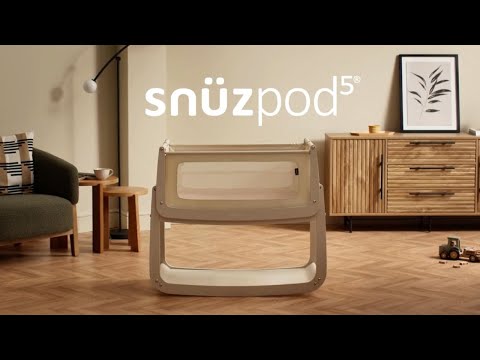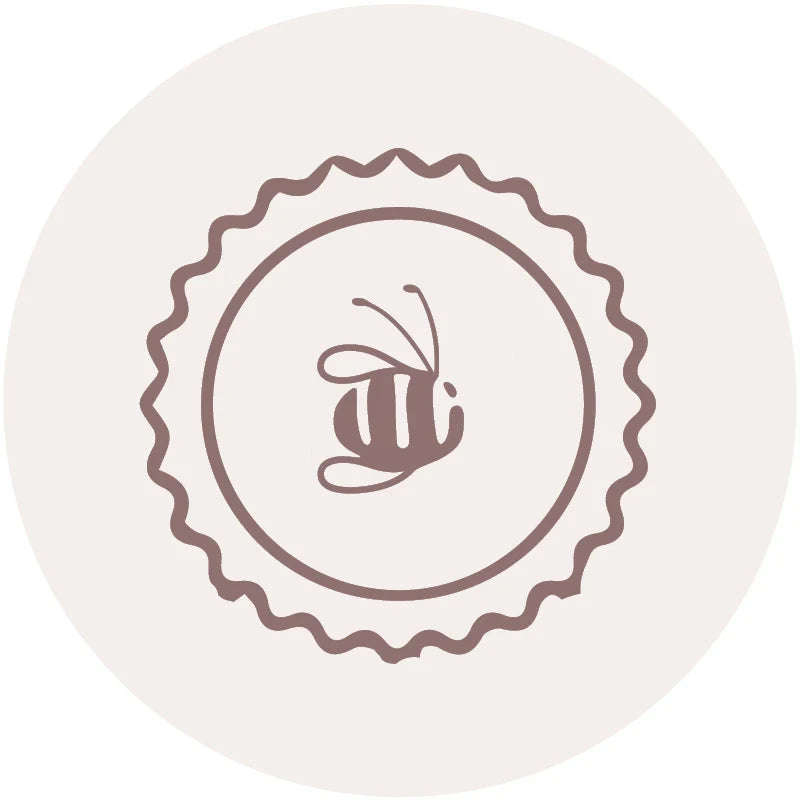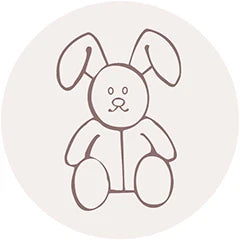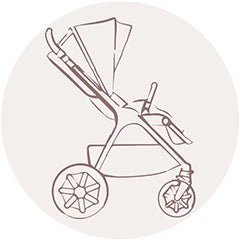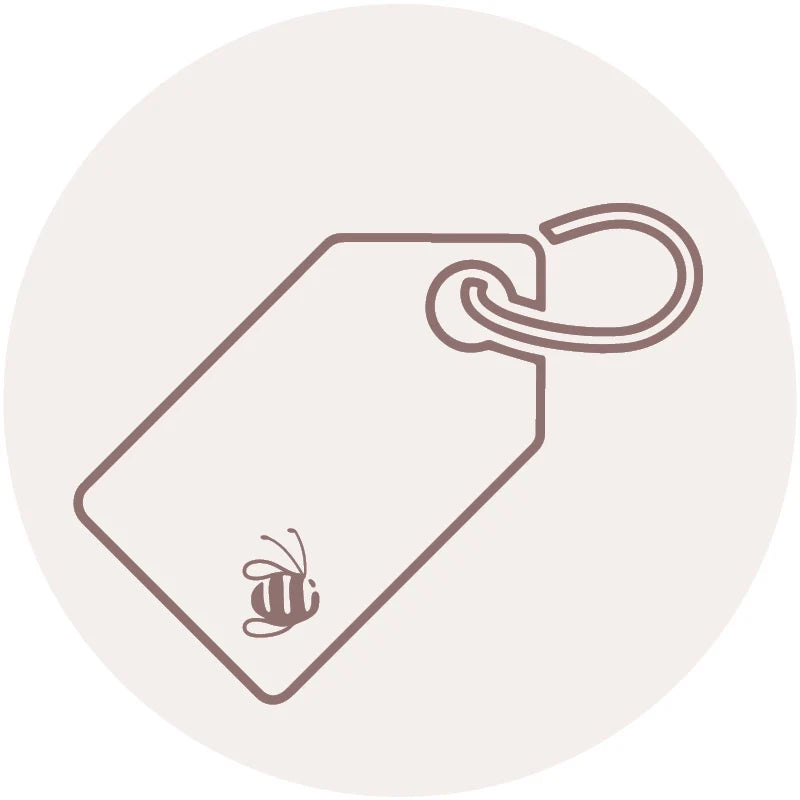Snuzpod 5
Snuzpod 5
SKU:FN050G
Clothing Prem to 18 Months
| Size | Age Guide | Weight | Height |
|---|---|---|---|
| Premature | Premature or Small Newborn | Up to 4Kg | Up to 55cm |
| Newborn | 0-3 months | 4-6Kg | Up to 62cm |
| 3 Month | 3-6 months | 6-8Kg | Up to 68cm |
| 6 Month | 6-12 Month | 8-10Kg | Up to 76cm |
| 12 Month | 12-18 Month | 10-12Kg | Up to 84cm |
| 18 Month | 18-24 Month | 12-14Kg | Up to 92cm |
Clothing 2 to 6 Years
| Size | Age Guide | Height | Chest | Waist | Hip |
|---|---|---|---|---|---|
| 2 Year | 2-3 Years | Up to 100 cm | 56 | 51 | 58 |
| 3 Year | 3-4 Years | Up to 105 cm | 58 | 53 | 60 |
| 4 Year | 4-5 Years | Up to 110 cm | 60 | 55 | 62 |
| 5 Year | 5-6 Years | Up to 115 cm | 62 | 57 | 64 |
| 6 Year | 6-7 Years | Up to 120 cm | 64 | 59 | 66 |
Beanie Size Guide
| Size | Head Circumference | Age Guide |
|---|---|---|
| Premature | 31-35 cm | Premature or Small Newborn |
| Newborn | 35-40 cm | Newborn |
| Small | 40-43 cm | 3-6 Months |
| Medium | 43-47 cm | 6-18 Months |
| Large | 47-52 cm | 18-3 Years |
Sunhat Size Guide
| Size | Head Circumference | Age Guide |
|---|---|---|
| Newborn | 37-40 cm | Newborn |
| Small | 40-43 cm | 3-6 Months |
| Medium | 43-46 cm | 6-12 Months |
| Large | 46-49 cm | 12-24 Months |
| Xtra Large | 49-54 cm | 2-4 Years |
Sleep Pods Size Guide
| Size | Weight | Age Guide | Measurement(Back to Hem) |
|---|---|---|---|
| Newborn | 0-6 kgs | 0-3 Months | 60.5 cm |
| Small | 0-8 kgs | 3-6 Months | 66 cm |
Booties Size Guide
| Size | Age Guide |
|---|---|
| Newborn | 0-3 Months |
| Small | 3-6 Months |
| Medium | 6-12 Months |
| Large | 12-18 Months |
Pretty Brave Baby
| Foot Length (mm) | Insole Length (mm) | EU | UK | Age | INT |
|---|---|---|---|---|---|
| 95-104 | 110 | 16/17 | 2 | 0-6m | S |
| 104-114 | 118 | 18 | 3 | 6-12m | M |
| 114-123 | 127 | 19/20 | 4.5 | 12-18m | L |
| 123-137 | 142 | 21/22 | 5.5 | 16-22m | XL |
Pretty Brave 1st Walker
| Foot Length (mm) | Insole Length (mm) | EU | UK | Age |
|---|---|---|---|---|
| 114-120 | 125-128 | 19 | 3 | 1 yr |
| 120-126 | 132-135 | 20 | 3.5 | 1-2 yrs |
| 126-132 | 138.5-141.5 | 21 | 4.5 | 1-2 yrs |
| 132-138 | 145-148.5 | 22 | 5 | 2 yrs |
Crywolf Swim Nappy
| Size | Length (waist to crotch) | Crotch Width (side to side) |
|---|---|---|
| 0-1 yr | 1-2 yrs | |
| 37 | 38 | |
| 14.5 | 15.5 |
Crywolf Rash Suit
| Size | Length (back neck to crotch) | Chest (arm to arm) | Waist (side to side) | Sleeve (neck to cuff) | Neck Opening(diameter) |
|---|---|---|---|---|---|
| 6-12 Months | 1 yr | 2 yrs | 3 yrs | ||
| 40 | 42 | 44 | 46 | ||
| 25 | 26 | 27 | 28 | ||
| 24 | 25 | 26 | 27 | ||
| 30 | 31.5 | 33 | 34.5 | ||
| 13.25 | 13.25 | 13.8 | 14.3 |
In stock
Couldn't load pickup availability
Overview
Overview
The SnüzPod5 in Cashmere colour is the latest generation of the award winning bedside crib that’s cradled over a million dreams!
Designed to support you and your baby through those precious first six months, SnüzPod5 brings together comfort, safety and style in one beautifully made sleep space. With a lift off bassinet, smooth rocking stand and wheels for easy portability, it adapts to your routine from day to night.
Dual view mesh windows and a 3D breathable mattress help regulate airflow to keep your baby cool and comfortable, while the zip down wall allows for easy nighttime feeds and soothing without leaving your bed.
Crafted in a collection of elegant interior inspired shades, SnüzPod5 redefines modern parenting with intelligent design that grows with your littlest love.
What's Included
What's Included
Key Features
Key Features
Technical Specification
Technical Specification
User Guide
User Guide
Delivery and Returns
Delivery and Returns
- Delivery: Free within NZ on orders over $100 (excluding bulky items) or $8 standard shipping
- Returns: Accepted within 14 days of receipt with proof of purchase
- Some items are excluded from returns including sale items, hardware, car seats, prams, monitors and personal items - please click here for the full list.
Share this product
Recently Viewed Products
Related Blogs
How to Dress your baby for Sleep
Dressing Your Baby for Sleep – A Seasonal Guide Knowing how to dress your baby at bedtime can feel like a bit of a guessing game – especially when the seasons start to change. Should you add another layer? Is the room too cool? Are their hands meant to be that cold? To help take the guesswork out, we’ve put together a simple guide to dressing your little one for sleep using our Dimples sleeping bags and sleepwalkers, without any additional blankets. A Gentle Reminder Every baby is different, so this guide is just that – a guide. The best way to check if your baby is at a comfortable temperature is by feeling the back of their neck. It should feel warm, not hot or sweaty. Hands and feet can feel cooler and aren't always a reliable indicator. Baby’s body temperature naturally dips during the early morning hours, so if your little one is waking more often than usual, it might be worth checking if they’re feeling a bit chilly. And remember – when it comes to sleep, it’s safer for babies to be slightly cool rather than too warm. Choosing the Right Layers When dressing your baby, natural fibres like Merino wool or cotton are best. These breathable fabrics help regulate temperature and keep your baby comfortable through the night. Merino in particular is a year-round superstar – its clever fibres trap warm air on cooler nights and allow heat to escape on warmer ones, making it ideal for all seasons. At Dimples, all of our garments are designed especially for keeping little ones cosy and safe. We recommend having at least two sleeping bags or sleepwalkers on hand for each season, so you’re always prepared for the inevitable midnight messes. Ideal Room Temperature The ideal temperature for a baby’s room is between 16–20°C. If you’re using a heater or heat pump, setting the thermostat to 18°C will help maintain a steady climate through the night without overheating. Monitoring the Room Many baby monitors display room temperature, which can be a helpful reference.Alternatively, something like the Shnuggle Moon Nightlight can be used to keep an eye on the room temperature. It uses a handy colour display to show whether the room is sitting within the ideal range. Signs Your Baby May Be Too Warm Waking more frequently than usual Sweaty back or neck Damp hair Shallow or rapid breathing If you notice these signs, try removing a layer or adjusting the room temperature. A cool, damp cloth on the back of their neck can help if they’re feeling very warm – and always check for fever if you’re concerned. Signs Your Baby May Be Too Cold Restless sleep or unusual movement around the cot Rolling onto their stomach Catnapping during the day Waking around 5am If any of these sound familiar, consider adding a layer, using a warmer sleeping bag, or gently warming the room. Dressing your baby for sleep doesn’t have to be stressful. With a few key pieces and a little trial and error, you’ll find the sweet spot that keeps them cosy and safe – all night long 😴 Explore our full sleepwear range to find breathable, natural fibre options for every season.And if you’re ever unsure, we’re here to help.
Learn moreSafely Co-Sleeping with your baby
Co-Sleeping With Your Newborn: What It Really Means 💤 The term co-sleeping simply means having your baby sleep in the same room as you. While it can be a hot topic among parents, co-sleeping doesn’t have to mean sharing your bed. It’s often about finding ways to be close, while keeping baby safe in their own sleep space. Every family is different, and your approach to sleep might look different to your friend’s. That’s perfectly okay. Some parents find that co-sleeping helps with easier night-time feeds, supports milk supply, and even helps everyone get a little more shut-eye. There’s also strong evidence that sleeping in the same room as your baby reduces the risk of SIDS. Bedside Bassinets: A Safe Way to Co-Sleep 👶 Room-sharing doesn’t mean bed-sharing. A great alternative is using a bedside bassinet, which allows your baby to sleep safely in their own space, right beside you. This setup gives you easy access for feeding or settling in the night, without having to get out of bed. If you’ve decided co-sleeping works best for your family, Dimples offers some thoughtful, safe-sleep options to support your journey. Shnuggle Air Crib: Comfort and Versatility 🌙 The Shnuggle Air Light Bedside Crib makes co-sleeping easier and safer. Designed to function as both a standard bassinet and a bedside sleeper, you can drop one side of the crib for quick access to your baby at night. A raised edge remains in place to prevent any accidental rolling, so baby stays safely in their own space. With adjustable height settings, you can align the crib perfectly with your bed. Its dual-view mesh sides help with airflow and visibility, so you can always keep an eye on your little one. It also includes a hypo-allergenic fibre mattress, which is 50% more breathable than standard foam and firm enough to support safe newborn sleep. And when your baby is ready for a cot? The Shnuggle Air Crib can transition with them. Just add the cot conversion kit and you’ll have a longer-term sleep solution without needing to invest in multiple beds. SnuzPod5 Bedside Bassinet: Style Meets Safety 🛏️ The SnuzPod5 is another excellent option for co-sleeping families. Designed with both parents and babies in mind, this award-winning bedside bassinet keeps your little one close while offering smart safety features and modern style. Its standout ComfortAir™ system helps regulate temperature and airflow through 3D breathable mesh sides and a perforated base. The zip-down wall means you can lift baby out for feeds without straining, while the bassinet stays safely anchored next to your bed. The SnuzPod5 fits more beds than ever before thanks to its adjustable height settings. The improved rocking stand allows for gentle motion to help soothe baby to sleep, or you can lock it in place when needed. With a reflux incline feature, washable fabrics, and thoughtful touches like a lightweight lift-off bassinet for daytime naps, the SnuzPod5 supports safe, convenient sleep from day one. Choosing What’s Right for Your Family 💛 There’s no one-size-fits-all answer when it comes to co-sleeping. What matters most is that your baby sleeps safely, whether that’s right beside your bed or in their own room. At Dimples, we’re here to support your sleep choices with a range of trusted, newborn-safe bassinets and cots to suit your lifestyle. Whether you're looking for convenience, flexibility, or long-term value, you'll find something that helps both you and your baby rest easier.
Learn moreReduce the Risk of SIDS
How to help keep your baby safe Entering the world of parenthood comes with its fair share of anxiety, from wondering how different your new life will be, to the worry of being responsible for a new little person. Sudden infant death syndrome (SIDS), previously known as ‘cot death’, is the unexplained death (typically during sleep) of a seemingly healthy baby. While SIDS is a very real threat, with a little knowledge you can reduce many known contributing factors. Back to sleep You’ll no doubt hear this on repeat from midwives and Plunket nurses as soon as your little babe comes along and for very good reason. Babies who sleep on their stomachs are much more at risk of SIDS. While it’s not 100% understood exactly why experts believe it could be about re-inhaling stale air. Once your baby can happily roll over by themself, you don’t need to worry about sleeping positions any more. Make it a strictly smoke-free zone Smoking (and exposure to second-hand smoke) during pregnancy not only puts your baby at risk of health issues but increases the risk of SIDS too. It’s thought that nicotine can wreak havoc on a mechanism in their brain which senses a lack of oxygen and triggers breathing to start (called auto-resuscitation). So make sure it’s strictly a smoke-free zone when you’re pregnant and when your little one arrives, and that your family and friends are on board too. Welcome your new (temporary) roommate It’s widely recommended that your new babe bunks in with you (in their own safe sleeping space) for at least the first four to six months. This isn’t always practical for light sleepers, in which case a good breathing movement monitor set up in their nursery will give you peace of mind. A safe spot for slumber While room-sharing is recommended, bed-sharing isn’t. It can be so tempting to savour that extra time snuggled up in bed with your new babe, but bulky duvets, pillows and even an adult rolling can spell danger for little ones. Setting your baby up with their own safe space (like a portable Moses basket ) within arm’s reach is your best option. Be prepared to be suddenly jolted awake and find yourself sitting up in bed or a nursing chair with your baby in your arms – sleep deprivation can really grab hold of you in the early days. Sleeping with a baby on a chair or sofa is very dangerous, so to avoid this as much as possible, use the middle-of-the-night feeds as opportunities to clear out and edit that day’s photos on your phone (no doubt there will be plenty!) Your phone’s blue light will help keep you alert. Baby, it’s cold outside It’s important to make sure the room where your baby is sleeping is at a comfortable temperature. Bundling up babies at all times is an outdated theory – overheating is another substantial SIDS risk. Higher temperatures can put babies into a deeper slumber, making it difficult for them to wake if their breathing is obstructed. The recommended room temperature for a baby is 16 to 20 degrees, with around 18 degrees being ideal. To check your baby’s temperature, feel his back or tummy – it should feel warm. A great way to check the temperature of their nursery is with a combined nightlight/temperature sensor like the Moon Nightlight . Blankets (and everything else) be gone All those cute blankets, animal-shaped pillows and snuggly little toys that create a cosy-looking cot will need to stay in storage until your baby’s first birthday. Until then, all you need is a fitted sheet and wearable bedding like a Merino Sleep Pod to keep them warm. The key is to avoid anything that may cover their face and restrict breathing. Breastfeed if possible Experts aren’t sure why, but breastfeeding can significantly lower the risk of SIDS. The theory is that breastfeeding promotes the sucking and swallowing action, which develops muscles that keep the airway open while boosting brain development. Breastfed babies are generally lighter sleepers, too. This might not sound like a benefit at 2 am, but anything that helps reduce SIDS is a big plus. A big tick for pacifiers There tends to be negativity around using pacifiers, but they can not only be life-saving for unsettled babies during car trips, but also literally life-saving. Once again, it’s a bit of an unknown how pacifiers help, but there is a clear link – babies who use pacifiers are at lower risk of SIDS. As with breastfeeding, this could be due to more developed sucking and swallowing muscles that help keep airways open. If you’re breastfeeding, wait until this is well established (at least 4-6 weeks) before introducing a good quality silicone pacifier . Do what you can to reduce the risk While there are still a lot of unknowns with SIDS, being armed with what you can do to reduce as many risks as possible should put your mind at ease. Keep in mind that the risk of SIDS decreases after six months and is pretty rare after a baby’s first birthday.
Learn moreHow to make a cute, cosy and safe baby bed
Here’s what you really need to know about safe sleep It’s easy to get caught up in the dreamy images of babies curled up in plush bedding, surrounded by teddies and soft textures. But when it comes to real-life safe sleep, less is definitely more. Whether you’re still setting up the nursery or your baby is already here, creating a secure and snuggly sleep space is one of the best things you can do for their wellbeing - and your peace of mind. Understanding SUDI SUDI stands for Sudden Unexpected Death in Infancy, and while it sounds confronting, knowing the facts can be empowering. SUDI includes deaths from a range of sleep-related causes, including accidental suffocation and unexplained deaths (previously called SIDS). In New Zealand, it’s one of the most common causes of death for babies under one—but the good news is, there’s a lot we can do to reduce the risk. Research shows that a baby’s sleep environment plays a big role. Things like sleeping baby on their back, using a firm mattress, avoiding overheating, and keeping their sleep space free from loose items all help create a safe place for them to rest. SUDI is most likely to occur between 2 and 4 months, so starting safe sleep habits from day one is key. By following a few simple guidelines and making thoughtful choices around where and how your baby sleeps, you're helping create the safest possible start. Safe sleep isn’t about fear—it’s about giving your baby the best chance to thrive. Safe sleep basics: what to know One of the most important ways to reduce the risk of SUDI is to make sure your baby sleeps on their back, in their own bed, and in the same room as you for at least the first six months. Their sleep space should be simple, uncluttered, and specifically designed for babies. Keep your home smokefree, avoiding overheating, and ensuring your baby’s face remains uncovered during sleep. Here’s what that looks like in practice: Choose a compliant cot A safe night’s sleep starts with a compliant cot. In New Zealand, all cots must meet the AS/NZS 2172 safety standard, which covers features like the minimum depth, spacing between slats, and secure construction. Look for the safety label when buying, and avoid using broken or modified cots - even hand-me-downs. Having baby in their own cot or bassinet reduces the risk of accidental suffocation and overheating. Shop our safe and gorgeous range of bassinets and cots here. Pick a firm, snug-fitting mattress A firm mattress that fits tightly within the cot frame is essential to prevent your baby’s face from pressing into soft surfaces or becoming wedged in gaps. The mattress should be flat and supportive - not shaped or elevated, and free of damage. Bonus points for breathable materials and easy-clean features, especially if you’re dealing with frequent night-time messes. We stock several options that will keep your baby safe. Shop here. Stick to the essentials To keep your baby cosy and safe, layer their sleep space with: Waterproof mattress protector – Ideal for leaks and spills, a protector helps keep the mattress clean and hygienic. Choose breathable options like merino for added comfort. Fitted sheet – This is where you can add your splash of style. Soft, well-fitted cotton or merino sheets keep things simple and sweet without compromising safety. Swaddle or sleeping bag – Skip the loose blankets. Swaddling (if age-appropriate) or using a well-fitting sleeping bag helps regulate baby’s temperature without the risk of fabric covering their face. What not to include Soft toys, bumpers, loose blankets, pillows, or positioners should never be in the cot. These items, while cute, can increase the risk of suffocation. Even mobiles and cords should be securely out of reach. The safest bed is a clear one - nothing but baby, dressed for the room’s temperature, on their back. Monitor with peace of mind If it helps you rest easier, consider a reliable video or breathing monitor. While not essential, these can offer extra reassurance during naps and overnight, especially during the early months. Shop our range of monitors here A minimalist bed is a safe bed We know it might feel counterintuitive when you’re eager to make your baby’s space feel warm and welcoming. But safety should always come before styling. Keep it simple until your little one is at least 12 months old, when they’re better able to move around and regulate their temperature.
Learn more



